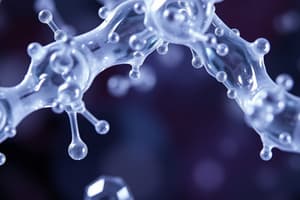Podcast
Questions and Answers
What effect does a change in pH have on an enzyme's activity?
What effect does a change in pH have on an enzyme's activity?
- It can affect the enzyme's structure and active site. (correct)
- It can improve binding to substrates.
- It only affects the temperature of the reaction.
- It has no effect on activity.
At what optimal pH does pepsin work best?
At what optimal pH does pepsin work best?
- Basic pH (around 12)
- Acidic pH (around 2) (correct)
- Neutral pH (around 7)
- Slightly alkaline pH (around 8)
What happens to enzymatic activity beyond the optimal temperature?
What happens to enzymatic activity beyond the optimal temperature?
- It begins to denature, reducing activity. (correct)
- It increases further.
- It becomes more efficient.
- It remains the same.
Which type of temperature conditions do most bacteria thrive in for optimal enzyme activity?
Which type of temperature conditions do most bacteria thrive in for optimal enzyme activity?
What does the bell-shaped curve in the pH and enzyme activity graph represent?
What does the bell-shaped curve in the pH and enzyme activity graph represent?
At what temperature do enzymes from mammals and birds typically function best?
At what temperature do enzymes from mammals and birds typically function best?
Which factor does NOT influence enzyme activity?
Which factor does NOT influence enzyme activity?
What results from enzyme denaturation?
What results from enzyme denaturation?
Flashcards
Enzymes
Enzymes
Proteins that speed up biochemical reactions within cells without being consumed in the process.
Optimal pH
Optimal pH
The pH at which an enzyme functions best.
Pepsin
Pepsin
An enzyme found in the stomach that breaks down proteins, with an optimal pH around 2 (very acidic).
Enzyme Denaturation
Enzyme Denaturation
Signup and view all the flashcards
Optimal Temperature
Optimal Temperature
Signup and view all the flashcards
Why do enzymes have an optimal pH?
Why do enzymes have an optimal pH?
Signup and view all the flashcards
Why do enzymes have an optimal temperature?
Why do enzymes have an optimal temperature?
Signup and view all the flashcards
What happens when an enzyme denatures?
What happens when an enzyme denatures?
Signup and view all the flashcards
Study Notes
Enzyme Activity and pH
- Most enzymes work best at a neutral pH (around 7)
- Enzymes have an optimal pH range where their activity is highest.
- Outside this range, enzyme activity decreases due to changes in the enzyme's shape.
- The shape of the enzyme's active site is affected by pH.
- The substrate may no longer fit into the active site if the pH deviates significantly from the optimum.
- Extreme pH values can permanently denature the enzyme.
Enzyme Activity and Temperature
- Enzymes function optimally within a specific temperature range.
- Enzyme activity increases as temperature increases, up to a point optimal temperature.
- Above the optimal temperature, enzyme activity rapidly decreases.
- High temperatures lead to denaturation of the enzyme's protein structure causing a permanent loss of function.
Optimal pH and Temperature
- Different organisms, like bacteria, in which optimal temperature could vary and which could be adapted to survive and function within extreme environments.
- Mammals and birds, maintaining a constant internal body temperature (homeostasis), their enzymes function optimally near 37°C.
- Enzymes evolved their temperature and pH optima to match their environment.
Studying That Suits You
Use AI to generate personalized quizzes and flashcards to suit your learning preferences.




